I have just returned from a 5-day workshop on deconstructed screen printing, at PROChemical & Dye, taught by fiber artist, Kerr Grabowski. Deconstructed screen printing is a technique I had experimented with on my own, not as successfully as I liked, so I decided to take this workshop from the woman who coined the term. The workshop was quite intense and full of exciting material. During the first couple of days, we learned a number of basic techniques but also had a chance to experiment with each. As the week progressed, we spent more time doing our own work, choosing the processes of most interest to each of us.
One thing I particularly liked about this workshop was the concentration and talent of the participants. Several attendees were serious studio artists, and most of those who weren’t aspired to becoming so as their lives allowed. Many people were fearless in their experiments, and there was a sharing and generosity that I have not always seen in other workshops.
In its most simplified form, deconstructed screen printing (DSP) involves preparing a screen with thickened Procion dye, letting the screen dry, and then removing the dye by printing it off with a clear (or colored) version of the same print paste that is used to thicken the dye. Often, before adding dye to the screen, textured objects are placed under the screen so that when the thickened dye is pulled across the screen, it will retain impressions of the objects used to texture it.
Whatever the technique used to change the screen from a plain screen to one with imagery, with each successive printing of the screen, more of the dried dye on the screen is dissolved. This means that all the prints are related, but each has its own distinctive look.
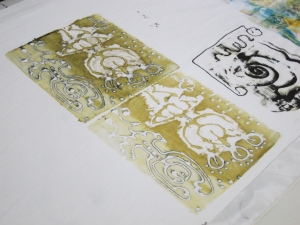
The Two Prints on the Left Resulted from Successive Printings of the Same Screen. These are Kerr’s prints
But making prints using textured objects is only the beginning. It is also possible to draw on the screen with wax which then serves as a resist when the screen is printed. Wax can also be painted on the screen in selected areas, giving a different look. In the next photo, Kerr is demonstrating the application of wax to a screen using a Javanese tool called a tjanting (or canting) that is traditionally used for batik.
Another technique taught in the workshop involved drawing on the screen with thickened dye using either a squeeze bottle or a syringe. The drawing was then dried and the screen was printed off. Each successive printing gave a different look to the lines that had been drawn on the screen.
These techniques are only a sample of the various ways this process can be used. One of the most interesting parts of the workshop was seeing how class participants interpreted deconstructed screen printing. Almost from the beginning, each participant’s work was different, carrying with it the stamp of the maker.
Most people worked on fabric, but one person, a paper and collage artist, used only paper. Her pieces were amazing, and a sample is shown below.
Below are some other examples of student work. The variations in imagery, color, and technique are all very evident.
For anyone seriously interested in DSP, I would highly recommend taking a workshop from Kerr. She teaches throughout the United States at various art center venues and also teaches abroad on occasion.


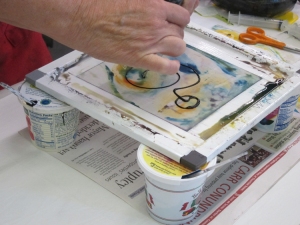
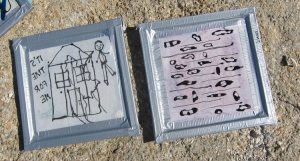
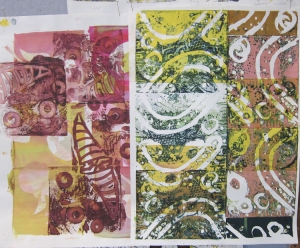
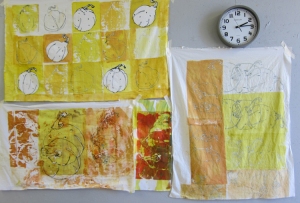
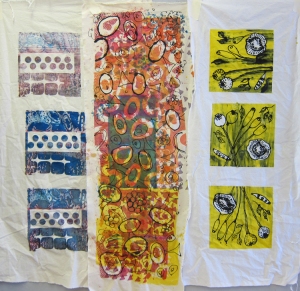
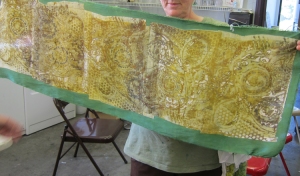
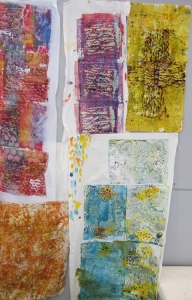

3 comments
Comments feed for this article
September 21, 2014 at 6:07 pm
turtlemoonimpressions
I concur wholeheartedly with your feelings about this workshop! So glad you got some good pics!
September 21, 2014 at 6:08 pm
Diane Franklin
Thanks. Me too. You’re welcome to lift them off the blog if you like.
September 23, 2014 at 10:53 am
The Students At Work | turtlemoonimpressions
[…] great pics of some of the artwork that was done, I’m linking to Diane Franklin’s, On Art, Inspiration and Everyday Life. My phone/camera died before I could get a bunch of pics, Diane’s was among those. But […]